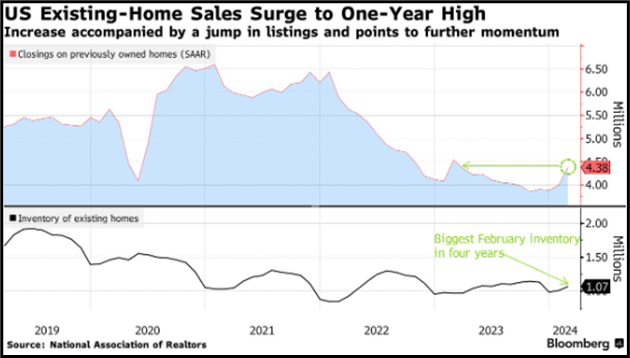The Federal Open Market Committee Issued Its Monetary Policy Statement and Held Rates Steady at 5.50%… After the announcement, the future probability of a rate cut rose to 67%.
What it means— Did anyone have “The Fed does exactly what it’s been telegraphing since November” on their bingo card? It’s like “opposite bingo,” where everyone knows the answer but refuses to write it down. The futures market jumped from a 50% chance of a rate cut in June to a 70% chance. There’s no convincing some people. In his press conference after the Monetary Policy Statement, Chair Powell essentially said the same thing he’s been saying for months, and the Fed’s summary of economic projections (SEP) bears that out. The Fed Open Market Committee (FOMC) participants expect to cut rates three times this year. The caveat is that the further out in time you go, the less certain things are. It’s still possible that the Fed will cut rates more this year as the economy stumbles, but so far, it’s been rocking along. However, the Fed has raised its estimate for 2024 economic growth from 2.4% to 2.6%.
Housing Starts Shot Higher in February, Reversing Most of the 12.3% Drop in January… Just as poor weather was blamed for falling starts in January, economists gave nice weather in February some credit for the rebound last month.
What it means— Amazingly, people still want to own homes. With mortgages settling around 6.60%, we still have a bottleneck on the demand side. We need rates at 6% or less to open the flood gates. Until then, builders are doing everything they can to scoop up buyers who just want to get in the game, since existing owners are in no hurry to lower prices.
Existing Home Sales increased 9.5% Over January but Are Lower Than Last February by 3.3%… The median existing home sale price rose 5.7%.
What it means— If you read the headlines, it sounds like we’re about to bust open the real estate market in a good way. If you look at the numbers, it’s not so compelling. With existing home sales at a 4.38 million annualized pace, we’re still 20% lower than the 5.34 million sales in 2019, before the pandemic. The inventory of homes for sale jumped 10%, but that was just 1.07 million units, a mere 2.7 months’ supply at the current sales pace. Existing home sales are no longer dropping, which is great, but we’d need to pick up the pace here in March and April, the prime season, to call it a rebound.

Netflix Airs South Korean Series About a Girl Who Transforms Into a Piece of Fried Chicken… Glazed fried chicken (dakgangjeong) is a staple in South Korea, so it makes sense to create a series where a girl turns into a chicken nugget, right? Based off of a webtoon in the late 2010s, “Chicken Nugget” has all the tropes. There’s a dad who runs a dakgangjeong shop, a boyfriend, and a very pretty young girl who turns into a chicken nugget in the shop. The boyfriend and dad spend the series trying to turn her back into the girl. Before you shake your head, remember that we spend billions to watch the adventures of “superheroes,” only one of which is neither altered in some way or from another world. Does it make you want to grab a bowl of chicken nuggets and turn on whatever superhero Marvel movie you like? In case you are wondering, the unaltered superhero is Iron Man, although he was born both smart and rich. (You could make an argument for Black Widow as well.)
Data supplied by HS Dent Research
“When the facts change, I change my mind.
What do you do?” ~ John Maynard Keynes
Our plan is “the plan will change.”
What is your plan?
Relative strength measures the price performance of a stock against a market average, a selected universe of stocks or a single alternative holding. Relative strength improves if it rises faster in an uptrend, or falls less in a downtrend. It is easily applied to individual positions in your portfolio and to sectors and asset classes.
A copy of our form ADV Part 2 is available online.
Please remember that past performance may not be indicative of future results. Different types of investments involve varying degrees of risk, and there can be no assurance that the future performance of any specific investment, investment strategy, or product (including the investments and/or investment strategies recommended or undertaken by Investor Resources, Inc. (“Investor Resources”), or any non-investment related content, made reference to directly or indirectly in this newsletter will be profitable, equal any corresponding indicated historical performance level(s), be suitable for your portfolio or individual situation, or prove successful. Due to various factors, including changing market conditions and/or applicable laws, the content may no longer be reflective of current opinions or positions. Moreover, you should not assume that any discussion or information contained in this newsletter serves as the receipt of, or as a substitute for, personalized investment advice from Investor Resources. Please remember to contact Investor Resources, in writing, if there are any changes in your personal/financial situation or investment objectives for the purpose of reviewing/evaluating/revising our previous recommendations and/or services, or if you would like to impose, add, or to modify any reasonable restrictions to our investment advisory services. Investor Resources shall continue to rely on the accuracy of information that you have provided. Investor Resources is neither a law firm, nor a certified public accounting firm, and no portion of the newsletter content should be construed as legal or accounting advice. A copy of Investor Resources’ current written disclosure Brochure discussing our advisory services and fees continues to remain available upon request or at https://www.investorresourcesinc.com/. Clients Please Note: Advise us if you have not been receiving account statements (at least quarterly) from Charles Schwab & Co.™

